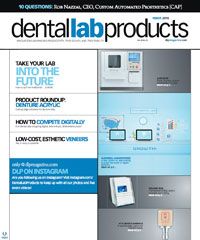Meeting the challenges of digitization
Throughout the course of several articles last year, we explored the future of digital dentistry and how it could help your lab counter business threats, grow and help you do highly esthetic work in a more cost-effective and efficient way. But what comes after digitization?
Mass-digitization of the dental lab industry is already underway, and, in my previous articles, I argued labs need to get on the digital bandwagon as soon as possible to stay competitive. But what happens after all labs are digitized-and being digital is no longer the deciding differentiator that keeps a lab’s business ahead of its competitors?
First, I foresee a future in which non-digital labs will have closed down, except for those few that manage to hang on to some of their customers due to long-term relationships. Some non-digital labs may survive by positioning themselves in niche areas. But the main industry drivers will be large, mid-sized and even smaller digital labs with efficient CAD/CAM systems.
New competition rules
With all contenders in the ring being digital, many labs will have similar offerings, and labs, at least those with top-of-the-market CAD/CAM systems, will basically be working with comparative possibilities in terms of production speed, available materials, quality and the range of indications they can offer. Inevitably, the dental lab market will lean more and more towards becoming a buyer’s market where dentists can easily shop around and switch providers without suffering major consequences. Therefore, digital labs will need to develop new differentiators-business models that are strong enough to maintain customer loyalty, win new clients and take the lead in their local markets.
From production lab to service lab
Many labs today are looked upon as production centers, delivering orders of dental restorations to their client base of dentists. Embracing CAD/CAM surely adds production speed, improved quality and more indications. But in a massively digital market, these improvements, although significant, will not by themselves change the perception of the lab’s role as yet another efficient production center among many others. Labs need to move from being production-only labs to become service-provider labs-while taking advantage of their digital technologies to get there. To put it shortly, labs that want to stand out need to shift focus, redefine their function for dentists and create a new place for themselves in the value chain.
Related reading: How to transition your lab from traditional to all-digital
New service tools enabled by CAD/CAM
Labs will require tools that make possible new service opportunities as supplements to restoration production. The best CAD/CAM providers will target their innovation and solutions to provide such tools to labs. Already today, advancements in technology and digital precision are bringing highly reliable tools to the market, and I expect that labs will take advantage of these to intensify the application of treatment planning in a larger number of cases. Additionally, 3D technology and Internet communication tools make it easy to provide clinics with pre-treatment visualizations so dentists can evaluate restoration designs and discuss cases with the patient.
Dental consultancy
A typical dental lab is a warehouse of knowledge. The combination of technician skills, wide-ranging case experience, materials expertise and CAD/CAM technology know-how represents a business asset that is both unique and valuable. Digital labs can easily position themselves as dental specialists and offer formal consultancy services-mainly to dentists but also to other labs, milling centers and practically anyone involved in the industry. Such activity is not only a potential revenue-bringing business model, but it also strengthens relationships with dentists and eventually brings in more work.
Enhancing the “service provider” image
As a dental lab’s service portfolio grows increasingly versatile, it becomes more and more important to promote its offerings and uniqueness in the market. As with any business, good marketing will help labs establish a strong image, reach more customers and beat competition. There are plenty of marketing channels available to labs-channels that do not require the clout of a whole marketing department. An active and communicative website, direct mail campaigns, social media and digital newsletters are just a few examples.
The future of dental labs
Digitization of the lab industry opens a realm of opportunity as well as new business challenges. More than ever, it will become imperative to strengthen customer relationships by shifting focus and business models from production to services for dentists. As a first step, those labs which have not yet embraced CAD/CAM should do so soon-because a lab’s CAD/CAM maturity will become a key competitive advantage when all the other labs discover they had better go digital as well.
Labs that have already fully integrated CAD/CAM into their workflows and business models, while building up technology expertise, will simply have a head-start in relation to many of the competition-winning factors, and a bright outlook to their future.

